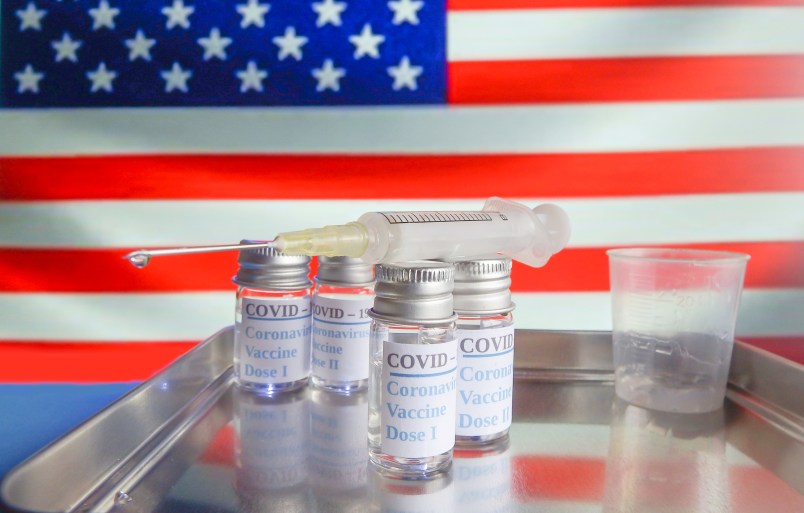ProPublica is a Pulitzer Prize-winning investigative newsroom. Sign up for The Big Story newsletter to receive stories like this one in your inbox.
As reports emerge across the country of health facilities throwing out unused and spoiled COVID-19 vaccines, some state governments are failing to track the wastage as required by the Centers for Disease Control and Prevention, leaving officials coordinating immunization efforts blind to exactly how many of the precious, limited doses are going into the trash and why.
In Washington, a health facility allegedly threw out some COVID-19 vaccine doses at the end of workers’ shifts because staff believed state guidelines blocked them from giving unused shots to people below the top priority tier. In Maryland, workers appear to have tossed thawed doses when they ran out of time to administer them safely. How many doses, exactly, have been wasted in those states is unknown because neither state is tracking unused or wasted vaccines.
In Indiana, where hospitals have told the media about discarding some shots, the state Health Department said it requires wastage to be reported but wasn’t able to tell ProPublica how many doses have been tossed statewide. Nonetheless, it asserted that “wastage has been minimal.”
Experts say that waste reporting is essential during a vaccination campaign to encourage careful handling and the use of every viable dose and, more importantly, to identify potential problems in the shipping and cold storage operations. With inconsistent reporting requirements and no enforcement of a federal mandate to report wastage, vaccine providers have little incentive to acknowledge wasting vaccines, said Dr. Ashish Jha, dean of the School of Public Health at Brown University.
Jha said he thinks that the true number of wasted doses across the country is far higher than a handful. After he detailed one anecdote he heard about an ER physician forced to waste vaccine doses in a thread on Twitter, his phone quickly filled with more than a dozen messages from other medical workers, confirming what he suspected: At a time when the U.S. is desperately short on vaccines, a significant number of doses are ending up in the trash.
Clinics and hospitals have “gotten slammed” when the media has learned of them wasting even a few doses, he said. “And the signal to everybody else is, if you have waste, don’t report it. Because if you do, you’re gonna get into a lot of trouble. That combination means, at least in my assessment, there’s a lot of waste and a lot of underreporting of that waste.”
The CDC requires all organizations that administer the vaccine to report the number of vaccine doses “that were unused, spoiled, expired, or wasted as required by the relevant jurisdiction.” The CDC also asked states to describe their wastage monitoring method during the distribution planning process.
Vaccine providers, such as pharmacies and hospitals, are supposed to provide data on wasted doses to their state health agencies, which then send the information to the CDC. Like many parts of the vaccine rollout, that has not gone according to plan. State by state, ProPublica found, reporting requirements vary and are not reliably communicated to vaccine providers. Even when the rules are clear, they are not regularly enforced, nor are numbers reported to the public.
Maryland’s Hospital Association said wastage data “is not systematically collected,” while the state’s Health Department said that “unless they are reported to us, MDH does not track specific instances of accidental vaccine wastage at the local level.”A Washington State Health Department spokesperson said that the state “does not systematically capture wasted dose information.” The spokesperson added that providers are encouraged to use up all of the shots they receive and that “if a provider doesn’t have enough qualifying employees under” the top priority group, “they can help vaccinate workers
who aren’t receiving vaccine directly from their employers.”
Michigan’s Department of Health and Human Services said, “We have not asked that vaccine providers report this data,” though it said that 10 wasted doses had been reported to it as of Jan. 13.In some cases, states said they were aware of specific instances of wastage. New Jersey said that it was “aware of 16 vials that had to be discarded because they arrived broken when the boxes were open.”
While a spokesperson noted that providers are instructed to give vaccines to people on waitlists to minimize the chances of vaccine being discarded, the spokesperson didn’t respond to questions about whether providers were mandated to report wasted doses.
Other states do have wastage reporting mandates. Pennsylvania, for example, said it requires providers to report any doses that are received and are not able to be used and was able to give a percentage — 0.1% of doses received for injections as of Jan. 11 — that had to be disposed of. “The majority of discarded vaccine is related to vials broken in handling and syringe issues, such as bent or broken needles or clients refusing after the vaccine dose was drawn,” said Department of Health spokesman Barry Ciccocioppo.
Colorado also said that waste is being tracked. “The state is aware that Pueblo Local Public Health rendered 300 doses of the Pfizer vaccine unusable after a portable vaccine storage unit malfunction,” a spokesperson from the state’s Joint Information Center said. “The state’s goal is to use every single available vaccine, acknowledging that emergencies may occur infrequently in the distribution process.”
In every mass vaccination effort, some share of doses unavoidably goes into the trash rather than arms. However, data on wasted shots — especially in large quantities — is an essential tool for federal and state health agencies trying to spot problems in how the vaccine is being shipped, stored and given to the public.
State vaccine officials monitor wastage numbers to determine if providers are mishandling shipments or improperly maintaining the temperature of their vials, said Dr. Kelly Moore, deputy director of the Immunization Action Coalition and former head of Tennessee’s immunization program. “Are they tracking things and responding appropriately, if you’re seeing extremely low wastage rates and everything is always perfect?” Moore said. “When things look too good to be true, they usually are.”
The two vaccines currently authorized, made by Moderna and Pfizer-BioNTech, both must be used within six hours of leaving cold storage, reaching room temperature and being opened. If there are no-shows for vaccination appointments, pharmacists have to quickly find replacements before the thawed vaccines expire.
Complicating the count is the fact that the number of doses available in a vial sometimes exceeds the amount prescribed on the label — pharmacists have commonly found that they can squeeze a sixth dose out of Pfizer’s vials, even though they are labeled as containing five. That means that a vaccine site could be allocated a certain number of doses on paper, have a few extra ones left that need to be tossed and still come out net positive. In that situation, it is unclear if the discarded doses should count as waste.
Data on wasted doses is routinely monitored in childhood immunizations in large part because it is required by the federal Vaccines For Children program, which provides innoculations to millions of children not covered by private health insurance, said Dr. Sean O’Leary, a professor of pediatric infectious diseases at University of Colorado Medicine. “Practices that are participating in that program, which are the vast majority of pediatric practices and a lot of family medicine practices, are used to keeping track very carefully of their vaccine inventory.”
There isn’t a federal program overseeing most adult vaccinations, so any wastage reporting for adult shots, like the flu shot, would be managed state by state.
While collecting wastage data is a good business practice, O’Leary said it is most useful as a deterrent against vaccine providers mishandling or discarding doses irresponsibly.
“It’s being tracked as a disincentive to letting [wastage] happen,” he said, “for accountability for people who are delivering the vaccines that they are doing their best to give the vaccines and store them properly.”
However, there is also a danger in stigmatizing the waste of vaccine doses, said Moore, the immunization coalition deputy director. Accidents and normal human error are going to make some vials unfit to use on patients. Doses compromised by unsafe temperatures or contamination need to be thrown out, not injected into people. “You never, ever want to have clinics feel pressured not to waste vaccine that needs to be wasted,” Moore said. “If you say, ‘No one should ever damage vaccine,’ you’re really going to be in trouble.”
The CDC says vaccine providers should avoid wastage and disclose when it happens.
“If there is excess vaccine, clinic staff should do everything possible to avoid wasting the dose. If vaccine wastage occurs, it should be reported into CDC’s Vaccine Tracking System (VTrckS),” said CDC spokeswoman Kristen Nordlund. “We are working to figure out how to provide this data online in the future when the data is more complete.”
In the meantime, federal officials have begun to urge that priority guidelines not get in the way of using vaccines. “It’s more important to get people vaccinated than to perfectly march through each prioritized group,” Alex Azar, secretary of health and human services under President Donald Trump, said at a briefing on Jan. 6.
This means that a pharmacist should use a dose that’s about to expire on any available person — even someone who isn’t in a priority group — rather than letting it go in the trash. “There’s always someone in line. The whole nation is in line,” said Lori Freeman, chief executive officer of the National Association of County and City Health Officials. “There’s no reason for any vaccine to go to waste.”
Dr. Mysheika Roberts, health commissioner of Columbus, Ohio, said in an interview last week that her local vaccination site hasn’t had to waste a single dose of vaccine so far. Initially, if there were extra doses at the end of the day, they used them on their own staff, she said. After that, the mayor allowed them to put police officers on the waitlist — even though only health care providers were technically eligible at the time — so the vaccinators could call the station if they had extra doses. Managing a waitlist is complicated, Roberts said, because you need to have people who want the vaccine and have both the transportation and flexibility to get to the vaccine clinic within about 30 minutes, but so far it has worked out. The vaccine clinic has also managed to further reduce potential waste by getting appointment confirmations and defrosting vaccine vials close to appointment times, she said.
An Ohio Department of Health spokesperson said the state requires providers to report waste, and that 165 doses of the vaccine had been recorded as wastage as of Jan. 15.
“I hope to never be in a position where I have to waste a dose,” Roberts added. “I’d go on a street corner and find someone to give the vaccine to before I have to throw it away.”



